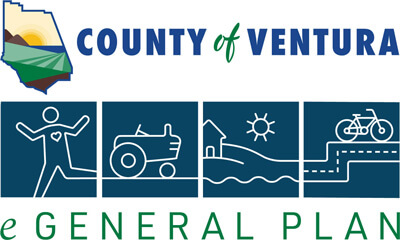This section focuses on reinforcing the County’s commitment to agricultural land preservation. Ventura County is a leader in effectively preserving agricultural land through land use policies, intergovernmental agreements, conservation programs, and voter initiatives. The County has taken several actions to direct growth away from agricultural and open space lands including the development of, and adherence to, the Guidelines for Orderly Development, greenbelt agreements, Save Open Space & Agricultural Resources measures, the California Land Conservation Act, and the County’s Initial Study Assessment Guidelines for implementing the California Environmental Quality Act (CEQA).
Guidelines for Orderly Development
Ventura County’s “Guidelines for Orderly Development” (Guidelines) were originally adopted by the Board of Supervisors, all city councils within Ventura County, and the Ventura Local Agency Formation Commission (LAFCo) in 1969. The County revised and readopted the Guidelines in December 1996. The intent of the Guidelines is threefold: (1) clarify the relationship between the cities and the County with respect to urban planning; (2) facilitate a better understanding regarding development standards and fees; and (3) identify the appropriate governmental agency responsible for making determinations on land use change requests. These Guidelines represent a unique, collaborative commitment to encourage urban development within cities whenever and wherever practical; enhance the regional responsibility of County government; and facilitate orderly planning and development in Ventura County. General Plan goals, policies, and implementation programs that integrate the Guidelines are primarily contained in the Land Use and Community Character Element.
Greenbelt Agreements
Beginning in 1967, several cities and the County began adopting greenbelt agreements. These are voluntary agreements between the County and one or more cities to limit development of agricultural and/or open space areas within the unincorporated county. Through greenbelt agreements, cities commit to not annex any property within a greenbelt while the County agrees to restrict development to uses consistent with existing agricultural or open space zoning. There are seven greenbelts in Ventura County covering approximately 164,000 acres collectively.
California Land Conservation Act
The state adopted the California Land Conservation Act in 1965, set forth at Government Code section 51200 et seq. (LCA, also known as the Williamson Act), to provide tax incentives to encourage the protection of agricultural and open space land. In 1969, the County adopted, and has subsequently revised, its “Guidelines for Implementation of the Land Conservation Act of 1965/the Williamson Act” (LCA Guidelines). All land with an Agricultural land use designation in the General Plan is considered an Agricultural Preserve under the LCA. The LCA is implemented through three contract types: LCA Contract, the Farmland Security Zone Area Contract (FSZA/LCA), and the Open Space Contract (OS/LCA). These contracts intend to preserve agricultural land and discourage its premature conversion to non-agricultural uses. Among other things, the LCA Guidelines establish eligibility criteria for these contracts. In exchange for the preservation of agricultural land, participating property owners receive a reduction of property taxes that are limited to the agricultural value of the property.
Initial Study Assessment Guidelines
The County adopted the Initial Study Assessment Guidelines (ISAGs) in 1992, and comprehensively revised them in April 2011. The ISAGs are intended to inform the public, project applicants, consultants, and County staff of the threshold criteria and standard methodology used in determining whether a project could have significant effects on the environment under CEQA. Regarding impacts to agricultural soils, the ISAGs state that any project that would result in the direct and/or indirect loss of soils designated Prime, Statewide Importance, Unique, or Local Importance on the State’s Important Farmland Inventory will have a significant impact. Furthermore, any project that would result in the direct or indirect loss of agricultural soils exceeding certain acreage-loss thresholds identified in the ISAGs will be considered to have a significant impact.
Save Open Space & Agricultural Resources (SOAR)
Ventura County voters first approved the countywide SOAR initiative measure in 1998. The County SOAR initiative requires countywide voter approval (i.e., approval by voters in both the unincorporated county and incorporated cities) of most changes to the General Plan involving the Agricultural, Open Space, or Rural land use designations, and most changes to a General Plan goal or policy related to those land use designations. In November 2016 by countywide vote, SOAR was renewed and extended through 2050. Goals, policies, and implementation programs from the 1988 General Plan that were referenced in the 2016 SOAR initiative are included in this General Plan, with only minor non-substantive revisions.
The policies in this section seek to continue the protection of the County’s agricultural lands and capabilities.
